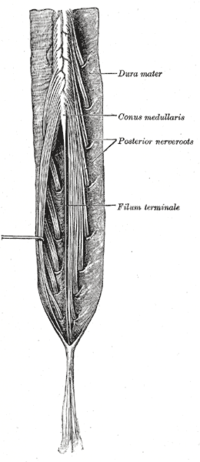
Photo from wikipedia
Abstract Introduction: Patients with cauda equina syndrome (CES) are frequently referred late when neurological damage cannot be reversed. National Guidelines for emergency referral, imaging and treatment of CES contain symptoms… Click to show full abstract
Abstract Introduction: Patients with cauda equina syndrome (CES) are frequently referred late when neurological damage cannot be reversed. National Guidelines for emergency referral, imaging and treatment of CES contain symptoms and/or signs that are those of late often, irreversible CES. Referral at this stage may be too late for that patient. Methods: Seven sources were reviewed. Advice re emergency referral/imaging/treatment were reviewed. Symptoms/signs were compared with a standard classification of CES. Results: 37 recommendations: 12 (32%) were symptoms/signs of bilateral radiculopathy (treatment usually leads to favourable outcomes). Thirteen recommendations (35%) were described in an imprecise way (could be interpreted as early or late CES). Twelve sets of symptoms/signs (32%) were those of late, often irreversible CES where an unfavourable outcome would be expected. Conclusions: Thirty-two percent of the so-called “red flag” symptoms and signs of CES in seven sources were definitely those of late, irreversible CES. These could be seen as “white flags” [flags of defeat and surrender]. Thirty-five percent of the recommendations if interpreted pessimistically (e.g. absent perineal sensation or urinary incontinence) would also be white flags; potentially therefore two-thirds of the so-called “red flag” symptoms/signs of CES could be those of late irreversible CES. Only 32% of the symptoms/signs were true “red flags” i.e. they warn of further, avoidable damage ahead. Guidelines should be redrawn to emphasise referral of patients who are at risk of developing CES or who have early CES. It is illogical for these guidelines to emphasise the clinical features of severe, often untreatable, CES. Demand for emergency MRI will increase; MRI is part of triage and should be performed at the DGH.
Journal Title: British Journal of Neurosurgery
Year Published: 2017
Link to full text (if available)
Share on Social Media: Sign Up to like & get
recommendations!